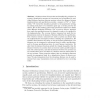Free Online Productivity Tools
i2Speak
i2Symbol
i2OCR
iTex2Img
iWeb2Print
iWeb2Shot
i2Type
iPdf2Split
iPdf2Merge
i2Bopomofo
i2Arabic
i2Style
i2Image
i2PDF
iLatex2Rtf
Sci2ools
CONCUR
2010
Springer
2010
Springer
Simulation Distances
Boolean notions of correctness are formalized by preorders on systems. Quantitative measures of correctness can be formalized by realvalued distance functions between systems, where the distance between implementation and specification provides a measure of "fit" or "desirability." We extend the simulation preorder to the quantitative setting, by making each player of a simulation game pay a certain price for her choices. We use the resulting games with quantitative objectives to define three different simulation distances. The correctness distance measures how much the specification must be changed in order to be satisfied by the implementation. The coverage distance measures how much the implementation restricts the degrees of freedom offered by the specification. The robustness distance measures how much a system can deviate from the implementation description without violating the specification. We consider these distances for safety as well as liveness specific...
CONCUR 2010 | Distance Functions | Distributed And Parallel Computing | Robustness Distance | Simulation Distances |
Related Content
| Added | 08 Nov 2010 |
| Updated | 08 Nov 2010 |
| Type | Conference |
| Year | 2010 |
| Where | CONCUR |
| Authors | Pavol Cerný, Thomas A. Henzinger, Arjun Radhakrishna |
Comments (0)

